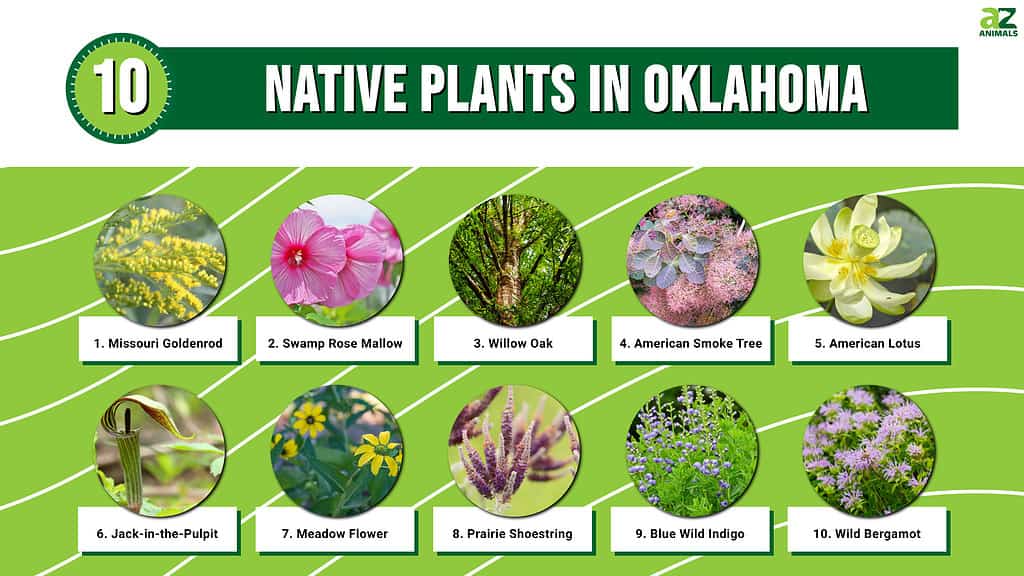
Many swamp rose-mallow hybrids are available for plant enthusiasts.
©
Oklahoma is located in the south-central part of the United States and is undoubtedly a natural gem! It features ancient mountain ranges, forests, prairies, and mesas, where numerous unique, stunning plants grow!
Almost a quarter of the state is covered in forests that serve as a natural habitat for various trees, shrubs, ferns, and wild animals. A study shows that only Muskogee County’s deciduous forests and grasslands are home to 829 species of vascular plants. Just imagine how many other species are throughout the state!
Of the thousands of species native to the state, the Oklahoma state flower became the Rosa ‘Oklahoma’ hybrid cultivar, which has a strong and sweet fragrance! The state wildflower is the Indian Blanket, a short-lived flowering plant that produces daisy-like inflorescences of bright red, yellow, and orange coloration!
Therefore, if you’re planning a trip to the Land of the Red Man or adding another plant to your garden, keep reading to learn about native plants in Oklahoma!
1. Missouri Goldenrod
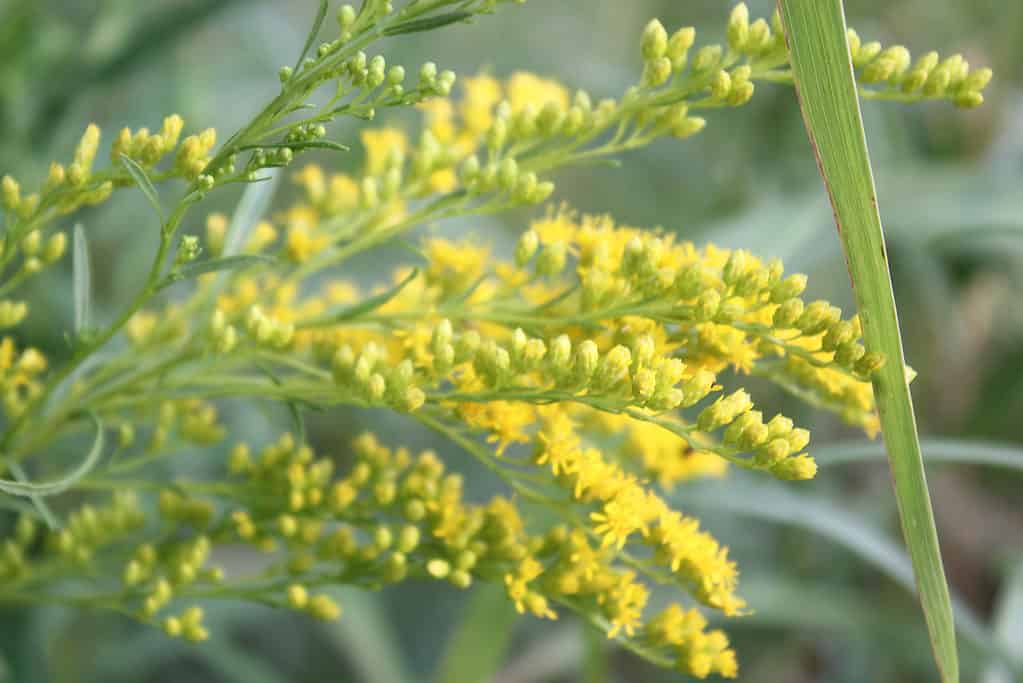
The Missouri goldenrod grows only up to 40 inches tall.
©iStock.com/PepperPoppy
| Missouri Goldenrod | |
|---|---|
| Scientific name | Solidago missouriensis |
| Other common names | Prairie goldenrod |
| Type of plant | Flowering perennial herb |
| Distribution | North America |
This highly adaptable plant is native to North America and produces rich and beautiful inflorescences! The Missouri goldenrod grows only up to 40 inches tall. However, despite its ground growth, the plant’s roots can go as deep as 6.6 feet underground, developing from a rhizome or a caudex.
The Missouri goldenrod has large leaves growing near the ground, which become smaller higher on the stem. The flower clusters grow on a branching panicle consisting of over 200 small flower heads. In turn, each head has 5 – 14 ray florets that surround 6 – 20 disc florets.
2. Swamp Rose Mallow
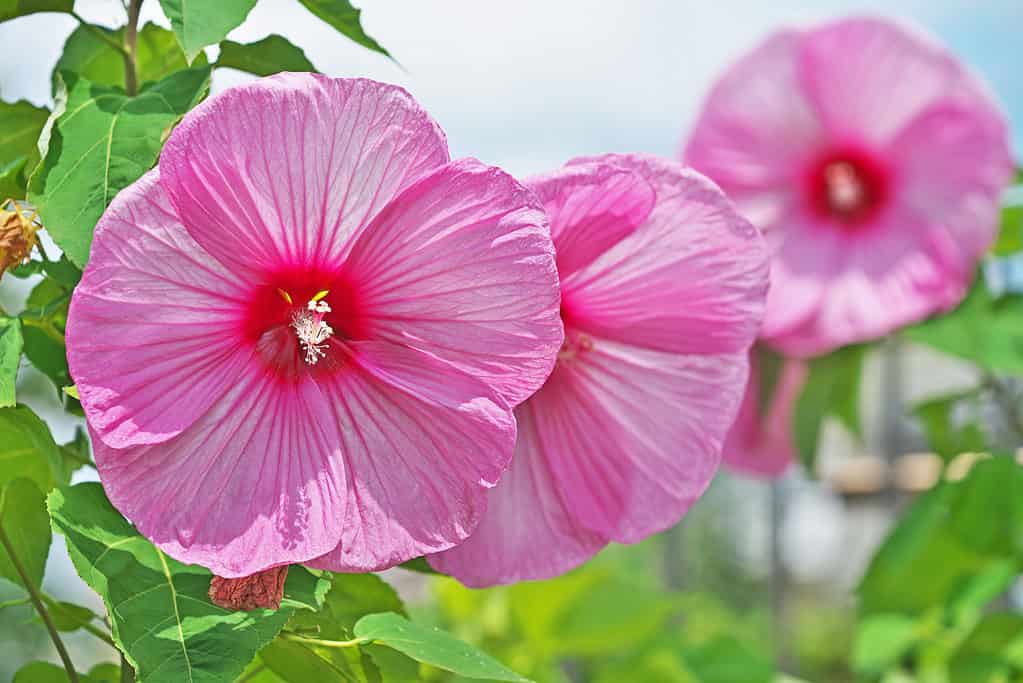
Swamp rose-mallow flowers can be of various colors, usually white or deep rose.
©iStock.com/igaguri_1
| Swamp Rose Mallow | |
|---|---|
| Scientific name | Hibiscus moscheutos |
| Other common names | Crimsoneyed rosemallow, eastern rosemallow |
| Type of plant | Flowering perennial |
| Distribution | Eastern and central United States |
The swamp rose-mallow isn’t only a beautiful wild plant; it’s also popular in gardening and landscaping! Its deltoidal leaves and distinctive flowers have great value in its habitat as the plant is a major food source for nectar-eating birds and insects. Swamp rose-mallow flowers can be of various colors, usually white or deep rose.
Nowadays, many swamp rose-mallow hybrids are available for plant enthusiasts, so if you’re planning to grow a native flower, you should add this species to your list!
3. Willow Oak
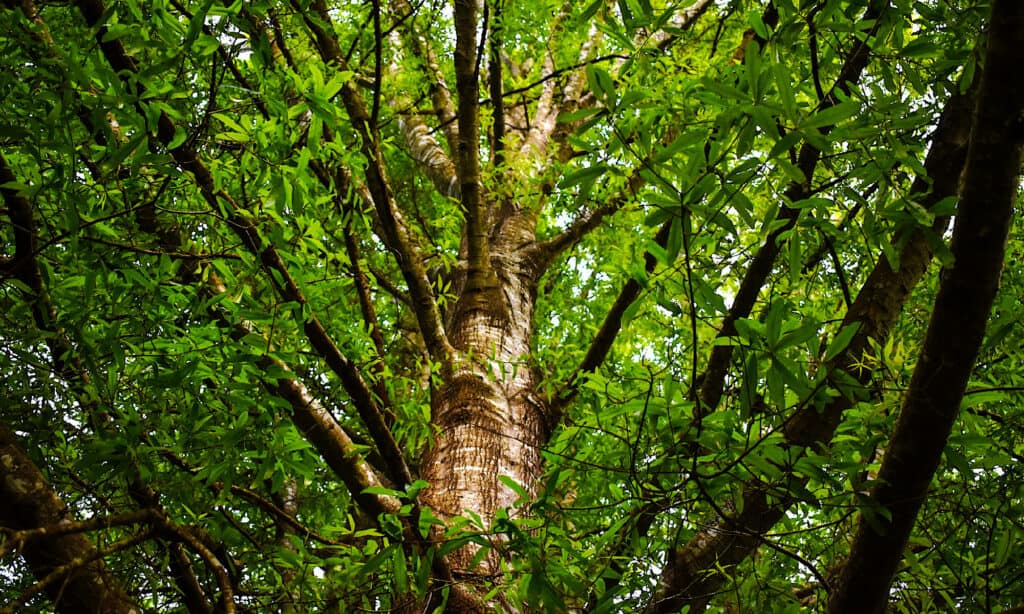
The willow oak produces acorns, although the fruits appear only when the tree reaches approximately 15 years of age.
©iStock.com/Caytlin Endicott
| Willow Oak | |
|---|---|
| Scientific name | Quercus phellos |
| Type of plant | Deciduous tree |
| Distribution | South-central and eastern United States |
The willow oak is a deciduous tree part of the Fagaceae family of flowering plants, alongside chestnuts and beeches. The tree can reach 100 feet tall and has unique leaves shaped like willow leaves – hence its name! The leaves are pale underneath but bright green on top.
The willow oak produces acorns, although the fruits appear only when the tree reaches approximately 15 years of age. These acorns are of significant wildlife value, as they represent one of the primary food sources for squirrels and other animals.
Besides their wildlife importance, willow oaks make excellent ornamental trees thanks to their rapid growth, low maintenance, and high adaptability. On the other hand, their wood is used for paper production!
4. American Smoke Tree

The American smoke tree flowers in summer, unraveling its distinctive pink-grayish flowers.
©christophe.dtr/Shutterstock.com
| American Smoke Tree | |
|---|---|
| Scientific name | Cotinus obovatus |
| Other common names | Chittamwood, American smokewood |
| Type of plant | Flowering deciduous shrub |
| Distribution | South-central and eastern United States |
The American smoke tree flowers in summer, unraveling its distinctive pink-grayish flowers. It has oval leaves that get a brilliant scarlet color when the temperatures drop. This unique color makes the tree famous for having the most intense fall colors.
While the American smoke tree is extremely rare in the wild, growing only in small areas in Oklahoma, Texas, Missouri, Arkansas, Alabama, and Tennessee, it is found in worldwide botanical gardens where plant enthusiasts can admire its rich foliage!
5. American Lotus

The American lotus has edible seeds, seedlike fruits, unopened leaves, and young stalks.
©Hernando Sorzano/Shutterstock.com
| American Lotus | |
|---|---|
| Scientific name | Nelumbo lutea |
| Other common names | Yellow lotus, volée, water-chinquapin |
| Type of plant | Aquatic flowering plant |
| Distribution | North America |
The American lotus is undoubtedly among the most beautiful plants in North America! It’s an aquatic plant that thrives in swamps and lakes and has its roots anchored in the mud. The flowers and the leaves grow above the water, making the plant look like it’s floating. The petioles can reach as much as 6.6 feet wide. Just imagine what a view you’d have if you spotted such a large American lotus!
The American lotus plant blooms from late spring to the summer months. The flowers are either white or pale yellow, have 22 – 25 petals, and measure approximately 7.1 – 11 inches in diameter.
Besides its incredible beauty, the American lotus has edible seeds, seedlike fruits, unopened leaves, and young stalks.
6. Jack-in-the-Pulpit
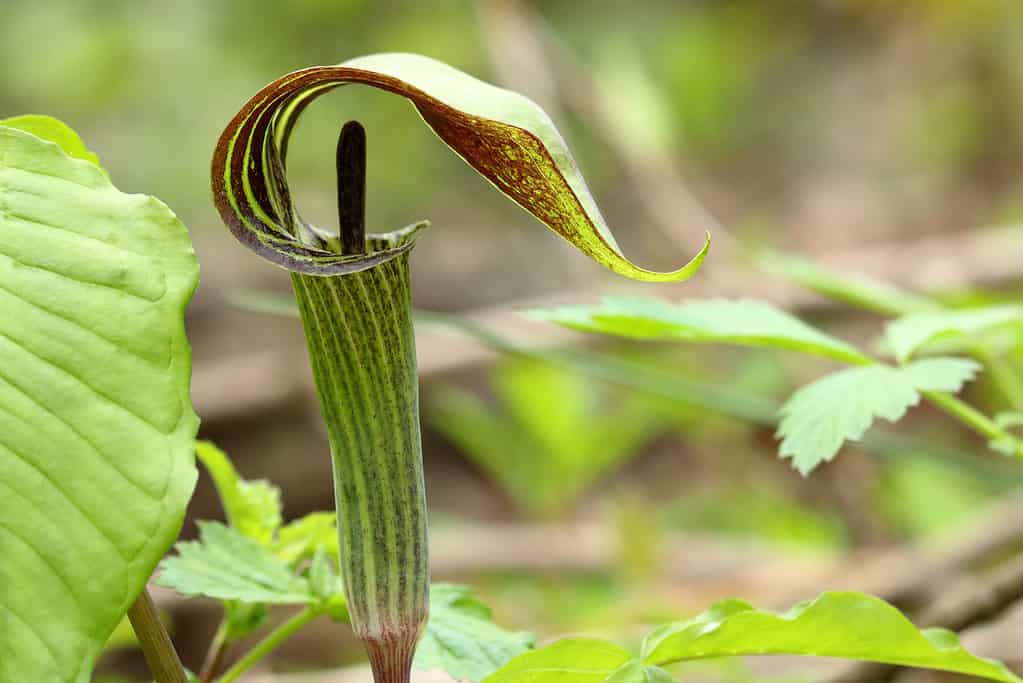
The jack-in-the-pulpit herbaceous perennial grows in moist woodlands and thickets.
©iStock.com/MelodyanneM
| Jack-in-the-Pulpit | |
|---|---|
| Scientific name | Arisaema triphyllum |
| Other common names | Bog onion, Indian turnip, brown dragon |
| Type of plant | Herbaceous perennial |
| Distribution | Eastern-central North America |
The jack-in-the-pulpit herbaceous perennial grows in moist woodlands and thickets. It has a long stem with three leaves grouped at the top. It blooms from April to June and produces greenish-yellow flowers. However, the flowers can sometimes be fully green and have brown or purple stripes.
Fungus gnats are the main jack-in-the-pulpit pollinators. Bog onion fruits are shiny green berries that ripen in late summer or early fall.
While the jack-in-the-pulpit plant is safe to eat if cooked, raw jack-in-the-pulpit may cause powerful burning sensations, mouth and digestive system irritation, and even severe allergic reactions.
7. Meadow Flower
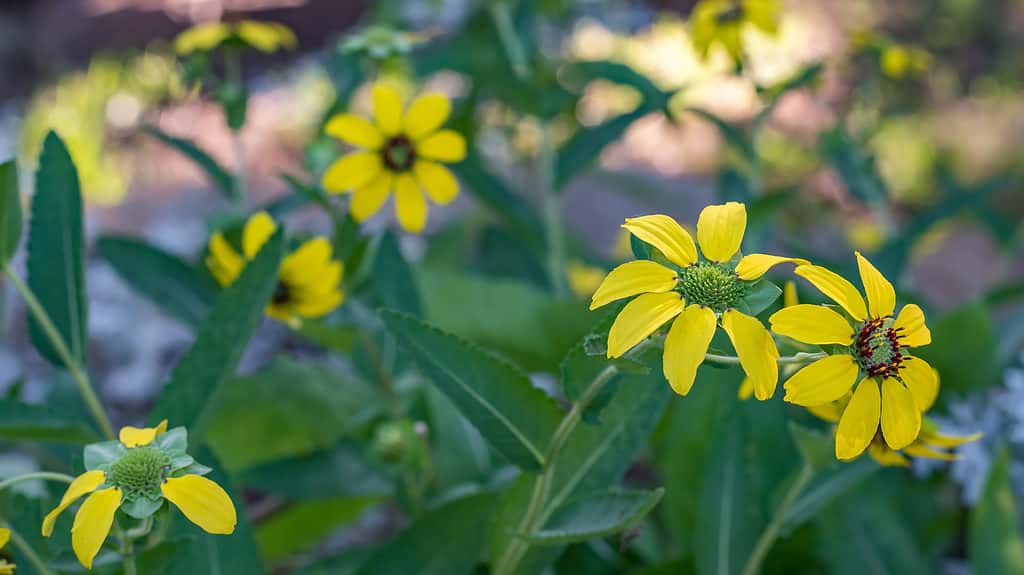
The meadow flower grows only in the south-central United States.
©iStock.com/Marianne Pfeil
| Meadow Flower | |
|---|---|
| Scientific name | Berlandiera texana |
| Other common names | Texas greeneyes |
| Type of plant | Flowering herb |
| Distribution | South-central United States |
The meadow flower grows only in the south-central United States, from New Mexico east to Louisiana and north to Kansas and Missouri, where it’s found in open woodlands and thickets. People also call it the Texas greeneyes.
The meadow flower plant grows only up to 4 feet and blooms from March to November, producing several flower heads that consist of red disc florets and yellow ray florets.
8. Prairie Shoestring

Prairie shoestring fruits are hairy legumes.
©iStock.com/MichellePatrickPhotographyLLC
| Prairie Shoestring | |
|---|---|
| Scientific name | Amorpha canescens |
| Other common names | Downy indigo bush, buffalo bellows, leadplant |
| Type of plant | Perennial semi-shrub |
| Distribution | North America |
The prairie shoestring has many other common names! You might’ve heard of it as the buffalo bellows or the downy indigo bush. It is common throughout North America, growing in dry prairies and savannas. It produces distinctive small purple flowers and gray-green leaflets. The flowers are grouped in long spikes, while the leaflets are alternately arranged. Prairie shoestring fruits are hairy legumes.
The prairie shoestring shrub was once used to treat various health issues, including rheumatism, pinworms, and eczema. However, it’s not as widely used in medicine nowadays. Instead, the plant is a valued landscaping and gardening shrub because it helps prevent erosion and has nitrogen-fixing properties.
9. Blue Wild Indigo
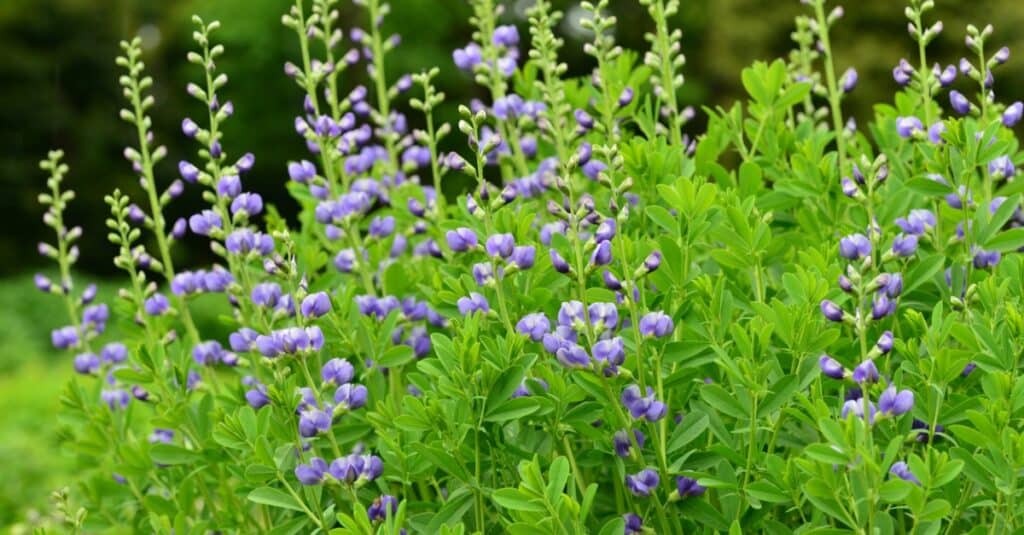
The blue wild indigo grows up to 4.9 feet tall.
©iStock.com/magicflute002
| Blue Wild Indigo | |
|---|---|
| Scientific name | Baptisia australis |
| Other common names | Blue false indigo, horsefly weed, rattleweed, indigo weed |
| Type of plant | Herbaceous perennial |
| Distribution | Central and eastern North America |
The blue wild indigo is also called blue false indigo because the plant often serves as a substitute for the dye-producing true indigo or Indigofera tinctoria.
The blue false indigo grows up to 4.9 feet tall. It has grayish-green trifoliate leaves that grow in an alternate arrangement. Moreover, it has obovate leaflets, while the flowers are of brilliant blue color and sometimes can even become deep violet. This herbaceous perennial blooms from spring to summer.
Some blue wild indigo parts, including the seeds, are considered poisonous, especially for children.
10. Wild Bergamot
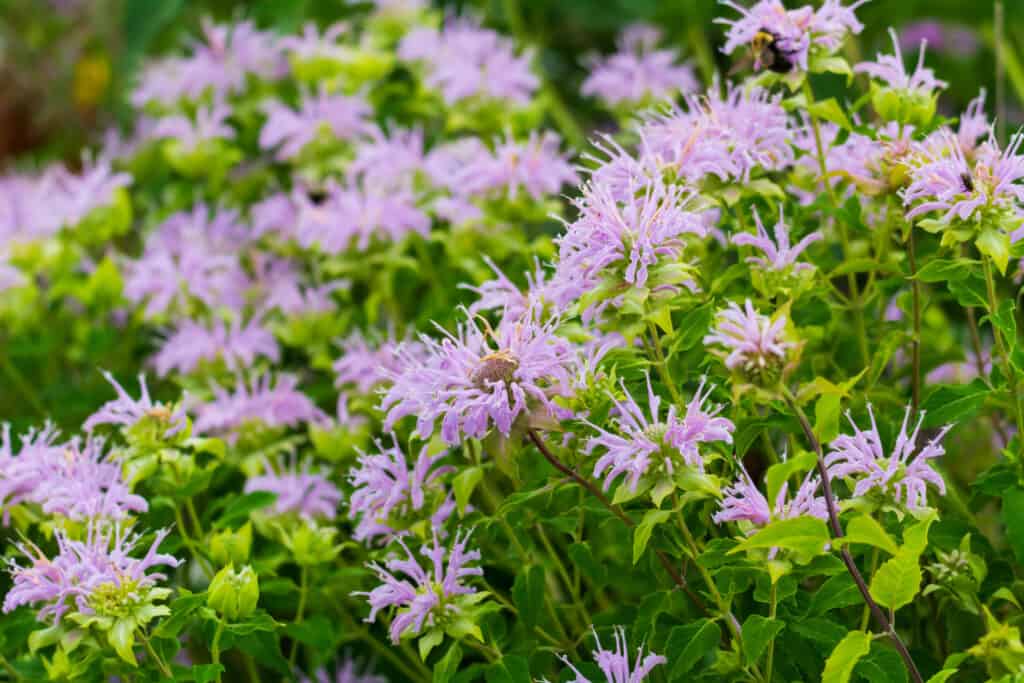
The wild bergamot is one of North America’s most common and abundantly spread plants.
©James W. Thompson/Shutterstock.com
| Wild Bergamot | |
|---|---|
| Scientific name | Monarda fistulosa |
| Other common names | Bee balm |
| Type of plant | Herbaceous perennial |
| Distribution | North America |
The wild bergamot is one of North America’s most common and abundantly spread plants. However, it’s most common in Georgia, Oklahoma, Texas, Idaho, and Arizona. It thrives in chalky soils in dry fields and thickets. It is widely known as a medicinal, honey, and ornamental plant!
The wild bergamot has compact clusters of purplish flowers that make the plant easy to distinguish in the wild. Besides this, the bee balm is known for its unique fragrance that attracts bees, lepidopteran species, and hummingbirds.
This plant is often used to treat colds and is very popular in tea-making.
Summary of 10 Native Plants in Oklahoma
| Number | Plant |
|---|---|
| 1 | Missouri Goldenrod |
| 2 | Swamp Rose Mallow |
| 3 | Willow Oak |
| 4 | American Smoke Tree |
| 5 | American Lotus |
| 6 | Jack-in-the-Pulpit |
| 7 | Meadow Flower |
| 8 | Prairie Shoestring |
| 9 | Blue Wild Indigo |
| 10 | Wild Bergamot |
The photo featured at the top of this post is © christophe.dtr/Shutterstock.com
Sources
- JSTOR, Available here: https://www.jstor.org/stable/2422980
- Oklahoma Native Plant Society, Available here: https://www.oknativeplants.org/native-gardening.html
- Gardenia, Available here: https://www.gardenia.net/native-plants/oklahoma?page=4
- The Nature Conservancy, Available here: https://www.nature.org/en-us/about-us/where-we-work/united-states/oklahoma/stories-in-oklahoma/native-gardening-in-oklahoma/
Thank you for reading! Have some feedback for us? Contact the AZ Animals editorial team.






